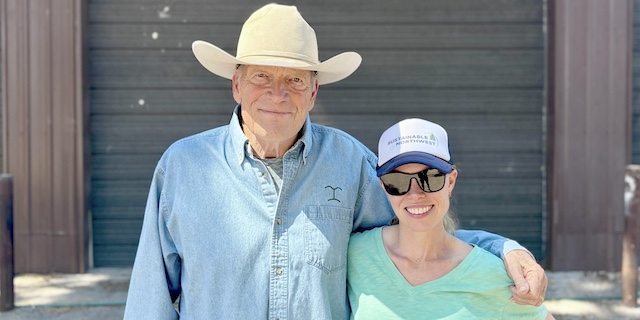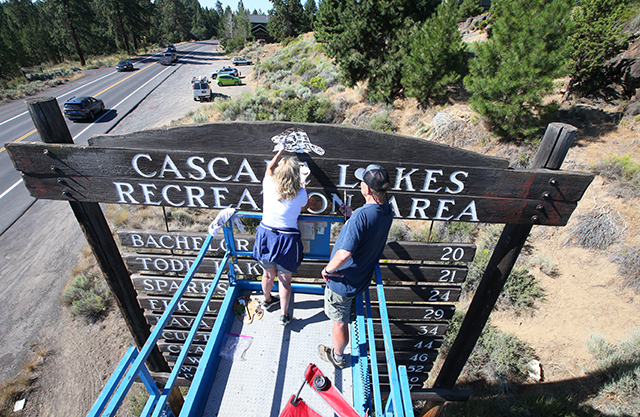Oregon Agricultural Trust gains ground in quest to protect ag properties
Published 8:11 am Friday, July 25, 2025

- Kurt Thomas and his daughter Kelley Delpit pose for a photo in mid-July at the Agency Ranch in Southern Oregon. The area near Crater Lake is wildly productive for forage, but neighbors are selling off properties and developing ranchettes. (Courtesy Kelley Delpit)
Kurt Thomas, whose family owns the Agency Ranch in Southern Oregon, preached three rules to his children at the dinner table.
“Get good grades, be respectful and don’t sell the ranch,” recalled daughter Kelley Delpit.
The Agency Ranch covers 2,000 acres near Crater Lake. With volcanic soils and plenty of water from springs, the area is wildly productive for forage, Thomas said.
Trending
Regardless, neighbors have been selling properties.
Thomas said they’re sometimes raking in obscene amounts to transform the land into ranchettes, smaller parcels providing just a taste of the country.
“The great enemy of this environment, of the ranches of the U.S. West, is the subdivisions of these pretty places,” Thomas added.
His family is working to protect their ranch forever, ensuring future generations can continue to run cattle — they’re finalizing a working land conservation easement with the Oregon Agricultural Trust.
The agreement will take the property off the board for additional housing while allowing ranching to continue.
The family will receive a substantial payment for foregoing their development rights, creating a financial cushion.
Trending
Delpit, Sustainable Northwest’s Klamath Program senior manager, said environmentalists and farmers often have been at odds over the years, but easements unify people.
“Conservation and agriculture can and should go hand-in-hand. It doesn’t have to be an either/or,” Delpit said.
Working with all of ag
OAT, which specializes in keeping ag land in production through working land conservation easements, formed in 2019 and is gaining momentum among farmers and ranchers.
Lackluster state funding and federal budget cuts could hamper its efforts, however. The nonprofit has lost millions of dollars of previously awarded grant money in the past few months.
Experts said the uncertainty comes at a critical time, as many Oregon farmers are nearing retirement age but don’t have succession plans.
So far, OAT has partnered with five farmers and ranchers to protect 30,800 acres across the state.
The operations vary in production, scale and region, and include conventional and organic businesses.
The smallest is a 45-acre Willamette Valley winery, orchard and forest. The largest is a 27,255-acre easement covering two ranch properties stretching across Malheur and Baker counties in Eastern Oregon.
That diversity is intentional and important, said Nellie McAdams, OAT’s executive director.
“I wanted folks to know we’re here for all agriculture. We just want to protect your land and support the business,” said McAdams, whose family grows hazelnuts, grass seed and timber.
OAT has 64 projects with 215,000 acres in the works, including the Agency Ranch.
How easements work
Most farmland conservation easements permanently protect the land’s agricultural and habitat values.
Landowners are compensated with cash or a tax deduction, which usually amounts to the value of the right to develop the land, as determined by an appraiser.
The property value is reduced to the agricultural value, making farmland more affordable.
Easement payments help fund succession or expansion by extracting value from real estate without selling the land.
Land trusts such as OAT can secure funds from the USDA and other government entities.
Dozens of land trusts operate in Oregon, but few are like OAT, which protects working ag lands but allows producers to adapt by changing practices or crops.
Oregon, despite strong zoning laws, is losing valuable farmland every year to development, fragmentation and conversion to non-farm use.
Though there’s disagreement on the degree of loss, it’s happening.
Keeping small ag going
Gabe Williams’ family has farmed in the John Day River territory since the late 1800s, raising hay and running cattle and sheep.
At the Twickenham Valley Ranch, their 1,600 acre spread near Mitchell, Ore., most nearby properties feature wealthy transplants or absentee owners. Even if newcomers continue farming, their focus is recreation.
“They’re wonderful folks but it’s just a whole different type of mentality, it’s a whole different lifestyle,” Williams said.
He works as an engineer in Bend, but returns to his childhood home nearly every weekend. A small operation can’t support many people, after all.
Land prices have skyrocketed and the best value for the family’s property undoubtedly is ranchettes, Williams said. Family members have received several unsolicited offers to sell.
“I don’t want that to happen. It’s not what my folks would have wanted and it’s not what my siblings want,” he said.
An OAT easement was an easy decision.
“Conservation easements are going to be critical to keep small ag going. For some families, it’s the only way to keep their small farms going,” Williams said.
Ranchers face rising prices for maintenance, fencing materials and piping.
The easement removes incentive to sell the land in tough times. With its payment, the family will create a trust, using interest for unforeseen costs — whether that’s taxes, insurance, water rights, hiring a land use attorney or purchasing a tractor.
“It makes the ag itself more profitable and less stressful if you don’t have to worry about that part of things,” Williams said.
His family is looking to diversify with value-added products and agritourism by developing a vineyard and tasting room, as well as growing lavender.
The easement mitigates risks with expansion investments, Williams said.
“We don’t have to worry about not generating an income for a time frame,” he said.
OAT estimates roughly two-thirds of the state’s farmland, or 10 million acres, will change hands in the next 20 years, but as much as 80% of farmers and ranchers don’t have succession plans.
Providing peace of mind
Elanor O’Brien doesn’t have an heir for Persephone Farm, which covers 54 acres along the South Santiam River outside Lebanon, Ore.
“I can’t do this forever. It’s just too large of a property for me to manage myself,” O’Brien said.
The farm, a pioneer in Oregon’s organic movement, recently celebrated its 40th anniversary.
Founder Jeff Falen — O’Brien’s work and life partner — died in 2020. But before he died, the couple talked with OAT about protecting the land.
“OAT is still a relatively young organization and back then they were very young. There was the thought that they needed to get a track record and we could help with that,” O’Brien said.
This May, Persephone Farm became the fifth agricultural operation with an OAT easement.
O’Brien said the agreement lowers the property price, making it more accessible.
When the farm sells, O’Brien hopes to continue living there as a consultant.
Not long ago, Persephone Farm had more than 10 employees and 14 acres of fresh market vegetables.
In the wake of Falen’s death, O’Brien simplified things. She has two part-time workers and switched to growing vegetable seed on contract. Seed farming brings high yields from a small area, and cover crops now are zipping up much of the acreage.
O’Brien understands the potential here, and views Persephone Farm as a complex, massive organism she listens to and nurtures.
With the OAT easement, the land can provide communities a cornucopia for centuries to come.
O’Brien feels better knowing safeguards are in place. “It’s peace of mind. It really is,” she added.







